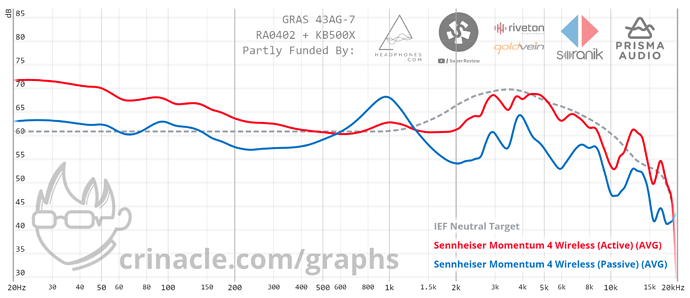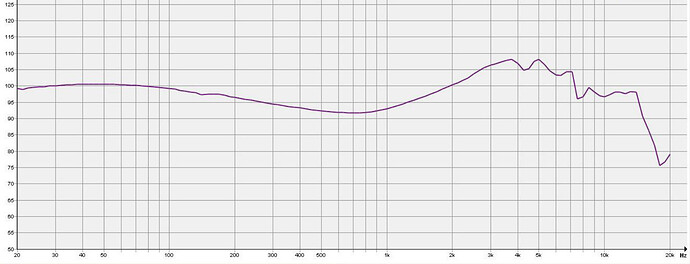Its not, DSP tuning is the future.
sadly enough it’s true…
Ok nice. I honestly havent heard about it. Are you able to explain what it is? Whatsbthe difference between this and a dac/amp?
DSP is essentially EQ tuning. Thats what most bluetooth transducers use.
Like this.
“active” is when the DSP is working. “stock” tuning is the “passive” one.
DSP´s do their work before the Dac converts the signal to analog.
quarks were pretty good for the price already, now a possibly better version, very tempting
I don’t know if DSP corrections is necessarily the future, it makes sense for wireless headphones because you’re correcting a poor driver and bad housing design to outweigh needing to manually tune anything. DSP is a tool and can only do so much, you still have to properly manually tune things and build cutting edge drivers to take it to that next level.
I don’t think it’s that easy. Look for example at the Warwick acoustics headphones. As Electrostatic headphones best you can get is a linear bass and that takes a lot of optimization. Same as with planars. Best you get is usually linear (the DCA stuff is interestingly the only outlier). So if you want to do the popular Harman tune what can you do? Warwick just throws DSP in their Amplifiers at the problem and thus gives you a rising bass response while leaving the hardware tuning free to be optimized for other factors.
So while most of the time it’s a do whatever and fix it with DSP sometimes it’s a necessity to overcome physical limits
I’d argue that popularity of bluetooth headphones and TWS makes DSP “the present”, not “the future”.
While DSP like EQ without a doubt is a very powerful tool for improving headphones’ sound, in my personal opinion it is not where the future of audio is - it is in AI* altering (improving) mixing and mastering.
Humorously speaking, even the best headphones with carefully crafted EQ can not help if a song sounds as if it was recorded with a potato. I can imagine being possible something like you have an app where you choose a song as a model for mixing and mastering and another song that will be transformed by the algorhitms.
The only problems I can see are that:
- it may require too much computing power to be run on a smartphone (even with future tech improvements)
- some kind of problems with copyrights regarding mixing and mastering
AI* in more coloquial sense, like very complicated algorithms
Ordered. What crazy value for money for budget listeners.
I agree 10000% with this.
With the higher end warwick, if you use the analog input the signal processing is also actually in the analog domain, so if you feed an analog signal into it, it will do it’s filtering with analog circuits rather than dsp, but if you use the internal dac then it’s going to be dsp. All dsp on the lower end model though for either analog or digital in. Also, there are estat options if you want a more elevated low end, though not to harman levels the sr007 with the right energizer is a good example of that. Or the he1 for that matter, it’s pretty damn harman
Only downside to the designing with dsp in mind approach is that it’s really best served with an entire system approach which limits flexibility and scalability. But it’s only one part of the puzzle in a system like that, it can only do so much, and relying on it too heavily typically results in pretty poor results from my experience
I thought the analog input of the Warwick’s was converted and then put through the digital chain but I probably misremembered.
If I read the graphs correctly the sr007 is working with an imperfect seal which gives a boost at the resonance but dropping the subbass sharply below that. So still a candidate for DSP or rather eq since like the Warwick stuff it seems even analog eq can go a long way.
I’d also assume that the he1 has some eq trickery going on since the “step” und the bass due to the membrane stretching iirc does show but with the bass being flat below that which would surprise me if that were natural. Maybe that’s why you only get the full system(atleast afaik)
And I agree that adding any corrections does limit flexibility a lot. Which makes the Metamaterial DCA uses pretty interesting since it seems like an tuning filter esque eq sort of.
That’s correct for anything using the sonoma M1 amp so the bravura and the older sonoma convert their analog input to digital, but the aperio will keep anything analog analog and keep anything digital digital
Somewhat yes, I’d say it’s overall a general warmth compared to other estats, but it’s not the most round elevation. Doing something like a spritzer/port mod to the 007 will really even out the bass and increase the seal (but that also sometimes messes with the measurements done as well), so yes the imperfect seal does boost the bass a decent bit. Similar with the abyss headphones, they have a lot more bass than they look to have depending on the fitment/seal
If you’re purely looking for a more even response then eq or dsp would do the trick, although some of the inherent limitations to estats in terms of bass still might bother people even if you increase prominence as they (to me) have never really had the physicality, weight, and macrodynamics of other driver types in the bass, and their inherently more speedy time domain may not satisfy people looking for a more pounding and loose response. So while dsp in an estat system can def help if you want more general warmth, it might not change other characteristics that might limit it from reacting as some might desire. Also assuming that introducing digital processing doesn’t do more harm than good which depends on how you go about doing it
Yeah no real way to know without looking inside, but I don’t know if grabbing a he1 to tear apart is really something many will decide to do lol. Although, if you are going to throw around that level of money, imo you’d be better off getting a he90/hev90 or a aperio, or a shangri la sr for that matter (sans their own amp)
It is pretty interesting, DCA/mrspeakers has always had an emphasis on physical filtering options in their products
When you have the signal in the digital domain, you can EQ without introducing Phase issues like any analogue EQ would.
Some other advantages of DSP is fine tuning time-domain. If you are okay with introducing the slightest amount of “lag” to the signal, you could have frequencies below a certain threshold begin to play earlier than higher notes.
Or you can compensate for speaker-mass (a tweeter has lass mass to move than a woofer), so you could artificially boost the signal band going to the woofers and time-advance it so the sound arrives at the listening position like emitted by a single driver.
So I hadn’t seen this anywhere but found it on Meaoes’ facebook – graph for their Eagle IEM:
Dual DD + 2 BA
It’s pretty cheap and comes bundled with a well-regarded bassy IEM to boot.
What’s the difference between Dual + 2 is the dual a concentric driver?
Have a feeling most 2DD IEMs on the market are actually just a single DD with two layers.
Sorry probably poor wording - it has two, one titanium one ceramic.
Not any of the recent ones I can think of?
Edit: Seems quite a few I’m less familiar with are “coaxial” like Riku has explained ![]()


